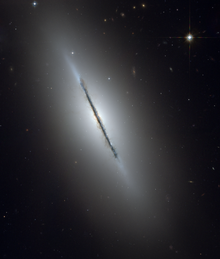Lenticular galaxy


A lenticular galaxy is a type of galaxy which is intermediate between an elliptical galaxy and a spiral galaxy in galaxy morphological classification schemes.[1] Lenticular galaxies are disc galaxies (like spiral galaxies) which have used up or lost most of their interstellar matter and therefore have very little ongoing star formation.[2] As a result, they consist mainly of aging stars (like elliptical galaxies). The dust in most lenticular galaxies is generally found only near the nucleus and generally follows the light profile of the galaxies' bulges. Because of their ill-defined spiral arms, if they are inclined face-on it is often difficult to distinguish between them and elliptical galaxies.
Morphological variations
Although lenticular galaxies do not vary in shape as much as spiral galaxies, they may still be divided into a series of subclasses based on their appearance. Some of these subclasses are described below.
Bars
In the de Vaucouleurs classification system, lenticular galaxies may be split into three subclasses based on the presence or absence of a central bar structure. The SA0 designation is used for lenticular galaxies with no apparent bars. The SB0 designation is used for galaxies with a strong bar. The SAB0 designation is an intermediate class that may be referred to as weakly barred.[1]
Inner ring and S-shaped subtypes
Some lenticular galaxies are also given inner ring (S0(r)) and S-shaped (S0(s)) designations as well as an intermediate designation (S0(rs)). However, these designations were defined primarily for spiral galaxies, and finding objects that represent some of these classes is very difficult.[1]
References
- ^ a b c R. J. Buta, H. G. Corwin, Jr., S. C. Odewahn (2007s). The de Vaucouleurs Atlas of Galaxies. Cambridge: Cambridge University. ISBN 0-521-82048-6.
{{cite book}}: Check|isbn=value: checksum (help)CS1 maint: multiple names: authors list (link) - ^ DeGraaff, Regina Barber; Blakeslee, John P.; Meurer, Gerhardt R.; Putman, Mary E. (December 2007). "A Galaxy in Transition: Structure, Globular Clusters, and Distance of the Star-Forming S0 Galaxy NGC 1533 in Dorado". The Astrophysical Journal. 671 (2): 1624–1639. doi:10.1086/523640.
{{cite journal}}: CS1 maint: date and year (link) CS1 maint: multiple names: authors list (link)
